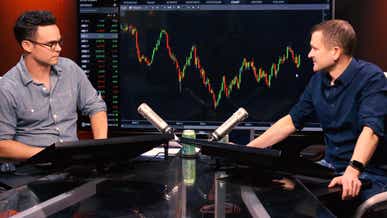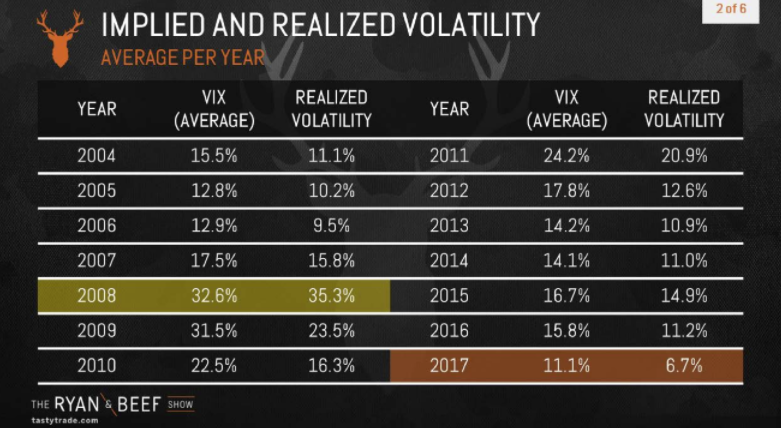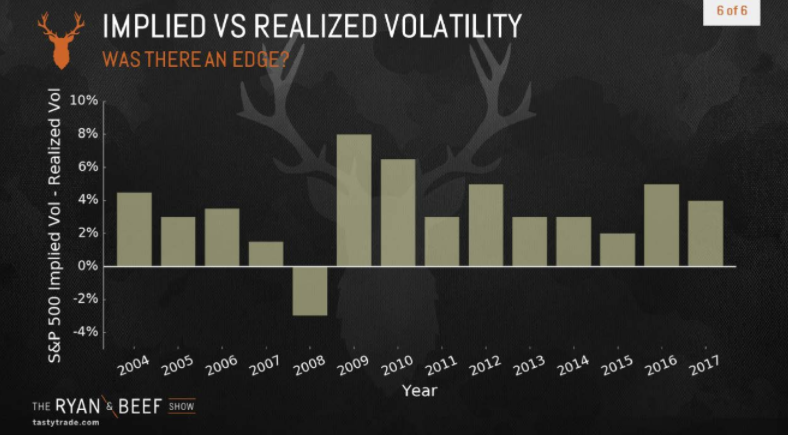Implied vs. Realized Volatility

Implied vs. Realized Volatility
Going by absolute levels in the VIX, it's easy to look back at 2017 as a year of record-breaking futility. After all, the VIX never even broke 19, which had been the approximate average in the metric over the past decade.
However, there's another element of the analysis that needs to be considered, as noted on a recent episode of Ryan & Beef.
Implied volatility represents the current market price for volatility, or the fair value of volatility based on the market's expectation for movement over a defined period of time.
Realized volatility, on the other hand, is the actual movement that occurs in a given underlying over a defined past period. For the VIX, that underlying is the S&P 500.
Volatility traders obviously care not only about what is expected but also what actually transpired.
Looking at data from 2004 to present, a snapshot of both implied and realized volatility over that period helps reframe 2017 in new perspective.
As you can see below, while 2017 implied volatility was certainly lower than usual, the relationship between implied and realized volatility remained fairly "normal":

Per the above graphic, the average VIX in 2017 was lower than any of the other years included in the analysis. However, realized volatility also dipped to its lowest level as compared to the other thirteen years examined.
This information begs the next question. How does the difference between implied volatility and realized volatility in 2017 compare to other years?
The chart below shows the difference between implied volatility and realized volatility by year (2004 to present):

According to the chart above, 2017 was much closer to an "average" year when it comes to the difference between implied volatility and realized volatility. From this perspective, the true outlying year in history is 2008, when realized volatility was actually higher than implied volatility - the only such instance over the period examined.
This episode of Ryan & Beef serves as an important reminder that absolute levels of implied volatility only tell half the story. That’s a big reason we use metrics such as Implied Volatility Rank (IVR) to assist with trading decisions.
So while implied volatility may have been anemic in 2017, the ultimate potential for opportunity (i.e. the difference between implied volatility and realized volatility) was much closer to “normal.”
We hope you’ll take the time to review the complete episode of Ryan & Beef when your schedule allows.
If you have any questions or comments on this material, don’t hesitate to contact us by leaving a message in the space below or sending an email to support@tastylive.com.
We look forward to hearing from you!
Sage Anderson has an extensive background trading equity derivatives and managing volatility-based portfolios. He has traded hundreds of thousands of contracts across the spectrum of industries in the single-stock universe.
Options involve risk and are not suitable for all investors. Please read Characteristics and Risks of Standardized Options before deciding to invest in options.
tastylive content is created, produced, and provided solely by tastylive, Inc. (“tastylive”) and is for informational and educational purposes only. It is not, nor is it intended to be, trading or investment advice or a recommendation that any security, futures contract, digital asset, other product, transaction, or investment strategy is suitable for any person. Trading securities, futures products, and digital assets involve risk and may result in a loss greater than the original amount invested. tastylive, through its content, financial programming or otherwise, does not provide investment or financial advice or make investment recommendations. Investment information provided may not be appropriate for all investors and is provided without respect to individual investor financial sophistication, financial situation, investing time horizon or risk tolerance. tastylive is not in the business of transacting securities trades, nor does it direct client commodity accounts or give commodity trading advice tailored to any particular client’s situation or investment objectives. Supporting documentation for any claims (including claims made on behalf of options programs), comparisons, statistics, or other technical data, if applicable, will be supplied upon request. tastylive is not a licensed financial adviser, registered investment adviser, or a registered broker-dealer. Options, futures, and futures options are not suitable for all investors. Prior to trading securities, options, futures, or futures options, please read the applicable risk disclosures, including, but not limited to, the Characteristics and Risks of Standardized Options Disclosure and the Futures and Exchange-Traded Options Risk Disclosure found on tastytrade.com/disclosures.
tastytrade, Inc. ("tastytrade”) is a registered broker-dealer and member of FINRA, NFA, and SIPC. tastytrade was previously known as tastyworks, Inc. (“tastyworks”). tastytrade offers self-directed brokerage accounts to its customers. tastytrade does not give financial or trading advice, nor does it make investment recommendations. You alone are responsible for making your investment and trading decisions and for evaluating the merits and risks associated with the use of tastytrade’s systems, services or products. tastytrade is a wholly-owned subsidiary of tastylive, Inc.
tastytrade has entered into a Marketing Agreement with tastylive (“Marketing Agent”) whereby tastytrade pays compensation to Marketing Agent to recommend tastytrade’s brokerage services. The existence of this Marketing Agreement should not be deemed as an endorsement or recommendation of Marketing Agent by tastytrade. tastytrade and Marketing Agent are separate entities with their own products and services. tastylive is the parent company of tastytrade.
tastyfx, LLC (“tastyfx”) is a Commodity Futures Trading Commission (“CFTC”) registered Retail Foreign Exchange Dealer (RFED) and Introducing Broker (IB) and Forex Dealer Member (FDM) of the National Futures Association (“NFA”) (NFA ID 0509630). Leveraged trading in foreign currency or off-exchange products on margin carries significant risk and may not be suitable for all investors. We advise you to carefully consider whether trading is appropriate for you based on your personal circumstances as you may lose more than you invest.
tastycrypto is provided solely by tasty Software Solutions, LLC. tasty Software Solutions, LLC is a separate but affiliate company of tastylive, Inc. Neither tastylive nor any of its affiliates are responsible for the products or services provided by tasty Software Solutions, LLC. Cryptocurrency trading is not suitable for all investors due to the number of risks involved. The value of any cryptocurrency, including digital assets pegged to fiat currency, commodities, or any other asset, may go to zero.
© copyright 2013 - 2025 tastylive, Inc. All Rights Reserved. Applicable portions of the Terms of Use on tastylive.com apply. Reproduction, adaptation, distribution, public display, exhibition for profit, or storage in any electronic storage media in whole or in part is prohibited under penalty of law, provided that you may download tastylive’s podcasts as necessary to view for personal use. tastylive was previously known as tastytrade, Inc. tastylive is a trademark/servicemark owned by tastylive, Inc.